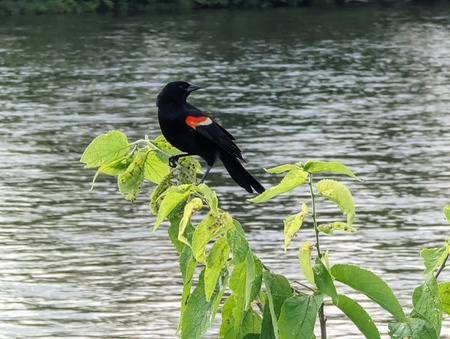
Good Natured: Red-Winged Blackbird Season
Every year about this time, certain wild neighbors start making headlines. Their behavior gets labeled aggressive, and people start calling them jerks—or worse.
Inevitably, someone will make an analogy to Alfred Hitchcock's The Birds, and then all heck breaks loose. “It tried to peck my eyes out!" someone will cry. “Scared the living [daylights] outta me!" someone else will exclaim. “I'm not going outside again until they're gone," I heard one individual say.
No doubt about it, the 2024 Red-winged Blackbird Season is underway.
For several years now we've fielded calls about how to deal with these jokers. Each time, we offer the same advice: Listen for their calls, find where they're perched, and give them a good, long stare.
Redwings are bold, for sure, and hell-bent on defending their territory. But they will not fly toward eyes. More on this later. First, let's take a look at why redwings are wired the way they are.
During the cold-weather months, these flamboyant birds really do play well with others. They join with assorted blackbird species and form flocks of hundreds or even thousands. They migrate short distances in search of grain fields and other sources of seeds, the primary component of their nonbreeding diet.
But as winter draws to a close, things begin to change—and fast. Male redwings break out first, leaving the flocks and returning to their breeding grounds when there's still snow in the air. They begin singing their reedy konk-a-reee songs as a means of declaring whose territory is whose. While there may be some sparring between individuals, the testosterone-charged birds at this stage pretty much keep to themselves.
It's not long though before these boys start escalating their behaviors. As female redwings begin to appear, each male has to defend his territory AND his mates, which can number from two on up to 15.
That's right, redwings are polygynous—one male mates with several females. (Fun fact: Of 278 breeding songbird species in North America, 15 are polygynous; of these, 11 live in marshes or grasslands.)
For a little perspective, think back to antics you may have witnessed by another common bird, the American robin. Males and females of this monogamous species both have been known to beat themselves silly as they try to outcompete their reflection in a window. Now imagine that drive times anywhere from 2 to 15, and you'll start to get an idea of what's going on inside a male redwing's head.
As the weeks pass by, the females build their nests and lay their eggs. After about 13 days, the eggs hatch, and the male's behavior ratchets up another notch. Besides his multiple mates, he now also has to protect what he perceives as his many offspring. (Another fun fact: Even tho a male redwing's territory may contain as many as 15 females, the young might not all be his. Female redwings may mate with nearby males as well.)
Defensive behavior hits its peak about two weeks after the eggs hatch, when the young start to fledge. Inexperienced at life, and with wings that don't yet work well, juvenile redwings need lots of protection. Females join the male in his defense of the territory, and things just get downright nuts—from our human perspective. The birds, it seems, are divebombing everyone who comes within striking distance.
Ah, but that is the time to refer back to the advice at the beginning of this column. Any time you find yourself walking near redwing habitat, be alert and you will beat them at their own game.
The birds rarely approach without first making some sort of warning sound. Their repertoire includes a scolding “chak," a “tjeet" and even a whistly rattle. (If you'd like to familiarize yourself with these calls without actually going near the birds, listen to the recordings on the red-winged blackbird page of Cornells' excellent www.allaboutbirds.org .)
Once you hear the sound, find where it's coming from. Look in the direction of the call and you'll likely see a male redwing, perched in a prominent spot. Keep your eyes on him as you pass by and, voila! No attack.
These birds are determined, for sure, but they're not stupid. They know full well that if they were to fly into the face of a threat, whether human, feline or otherwise, there's a good chance they wouldn't survive. A swipe of a hand, or paw, and it would be bye-bye birdie.
I played a little game of I Spy: The Redwing Edition other day as I walked on the Fox River Trail from St. Charles to Batavia. I spotted over a dozen of the handsome fellows, and while all eyed me suspiciously none of them swooped or bopped. I'll take that as a win!
This little sport will continue for as long as the birds deem necessary. But a few more weeks and the stakes will decrease. The offspring will be self-sufficient, the hormones will have subsided, and peace will return to the land.
For a few months. Then we can begin the countdown to Red-winged Blackbird Season 2025.
Pam Otto is the outreach ambassador for the St. Charles Park District. She can be reached at potto@stcparks.org.

